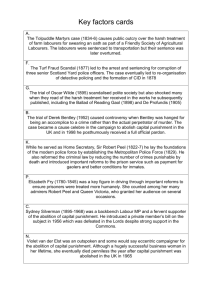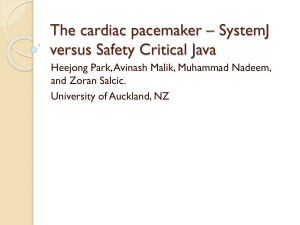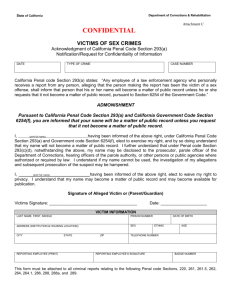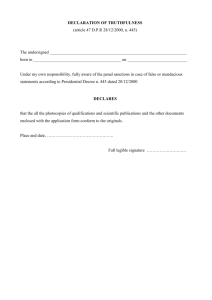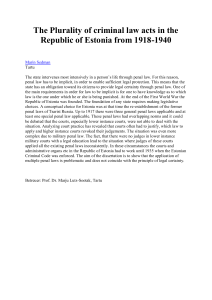The Supreme Court of Mauritius and the Objectives of Punishment in
advertisement
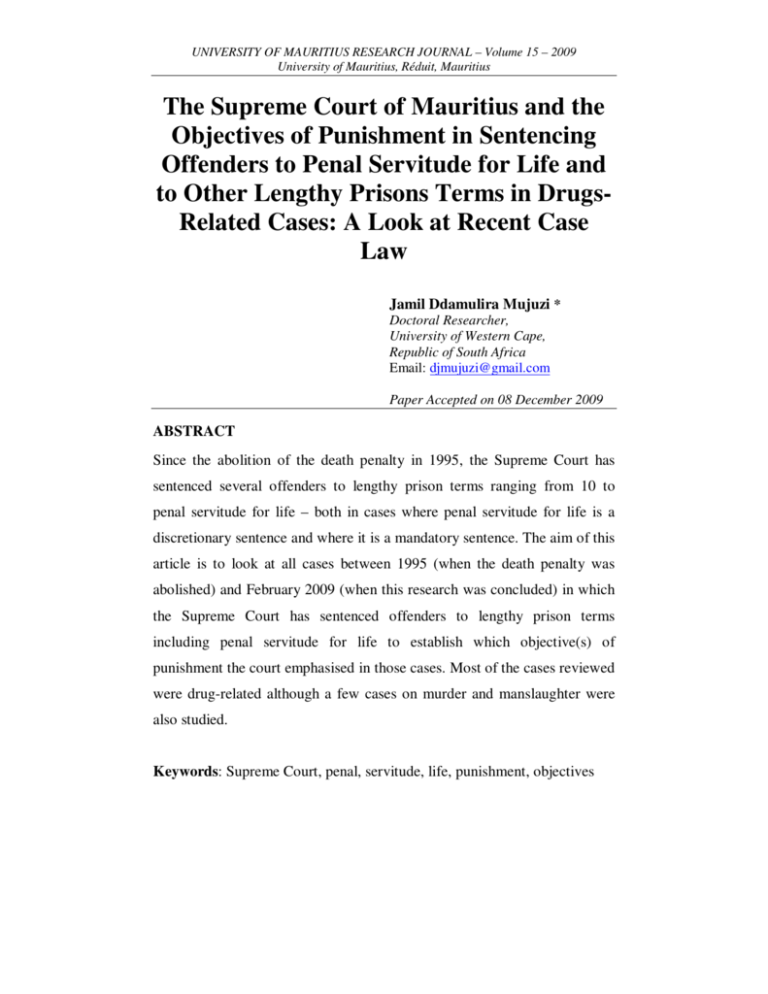
UNIVERSITY OF MAURITIUS RESEARCH JOURNAL – Volume 15 – 2009 University of Mauritius, Réduit, Mauritius The Supreme Court of Mauritius and the Objectives of Punishment in Sentencing Offenders to Penal Servitude for Life and to Other Lengthy Prisons Terms in DrugsRelated Cases: A Look at Recent Case Law Jamil Ddamulira Mujuzi * Doctoral Researcher, University of Western Cape, Republic of South Africa Email: djmujuzi@gmail.com Paper Accepted on 08 December 2009 ABSTRACT Since the abolition of the death penalty in 1995, the Supreme Court has sentenced several offenders to lengthy prison terms ranging from 10 to penal servitude for life – both in cases where penal servitude for life is a discretionary sentence and where it is a mandatory sentence. The aim of this article is to look at all cases between 1995 (when the death penalty was abolished) and February 2009 (when this research was concluded) in which the Supreme Court has sentenced offenders to lengthy prison terms including penal servitude for life to establish which objective(s) of punishment the court emphasised in those cases. Most of the cases reviewed were drug-related although a few cases on murder and manslaughter were also studied. Keywords: Supreme Court, penal, servitude, life, punishment, objectives Jamil D. Mujuzi 1. Introduction The sentence of penal servitude for life has had a very long history in Mauritius (Mujuzi, 2009). After the abolition of the death penalty, it became a mandatory sentence for drug-related crimes (section 28(1)(c) of the Dangerous Drugs Act). Mujuzi has recently exhaustively discussed the circumstances in which a mandatory or discretionary life sentence can be imposed and the law and practice relating to the release of offenders serving such sentences in Mauritius (Mujuzi, 2009). This discussion will not be repeated here. The Mauritian Supreme Court, the only court with the jurisdiction to impose penal servitude for life (Section 70A of the Courts Act), was also empowered to impose this sentence on offenders convicted of offences such as manslaughter. It has to be recalled that before the Supreme Court ruling in De Boucherville v Commissioner of Prisons and others, offenders sentenced to life imprisonment were being released after serving 20 years’ imprisonment (State of Mauritius v Jeetun, 2006). However, in this case the Supreme Court held that penal servitude for life should be given its natural meaning – that is, that the offender should be imprisoned for the rest of his life unless pardoned by the President. However, in 2008, the Privy Council held in the case of De Boucherville v The State of Mauritius in which the offender’s death sentence was commuted to penal servitude for life after the abolition of the death penalty, that penal servitude for life without the possibility of release was arbitrary and unconstitutional. Subsequently, the Supreme Court laid down the factors that should be considered before an offender sentenced to penal servitude for life is released (De Boucherville Roger FP v The State of Mauritius, 2009). Before the author embarks on the discussion of the objectives of punishment the Supreme Court has emphasised in sentencing offenders to penal servitude for life and to lengthy prison terms in drug-related offences, a short discussion of some of the objectives of punishment is warranted. 635 The Supreme Court of Mauritius and the Objectives of Punishment in Sentencing Offenders to Penal Servitude for Life: A Review of the Case Law 2. Objectives of punishment A detailed discussion of the objectives of punishment falls outside the confines of this article. However, it should be recalled that there are three major objectives of punishment: retribution, deterrence and rehabilitation (other objectives of punishment include restorative justice and reconciliation). Retribution is premised on the argument that the offender should be punished for breaking the law and not for any other reason such as deterrence and rehabilitation. Deterrence is founded on the philosophy that punishment can only be morally justified if it either deters would be criminals (general deterrence) or the offender himself (specific deterrence) from committing crime or reoffending respectively (Christopher, 2002). Rehabilitation, as the name suggests, is based on the theory that punishment should only be imposed for the purpose of rehabilitating or reforming the offender. Each of the above objectives of punishment has been criticised. Retribution has been criticised as revenge. Deterrence has been criticised as justifying the punishment of the innocent – if that is what is needed to prevent potential criminals; and rehabilitation has been criticised for justifying the indeterminate incarceration of offenders – if the prison authorities are of the view that such offenders have not been rehabilitated or reformed enough to be released (von Hirsch and Ashworth, 1998; Terblanche, 2007; and Schabas 2006). It is worth noting that research has shown that there is no or limited evidence to suggest that deterrent sentences are effective in reducing serious or organised crime (Tonry, 2008). 3. The Supreme Court and objectives of punishment in cases of penal servitude for life For many years, Mauritian courts have emphasised ‘retribution, the protection of society, the prevention of crime and the reformation of the 636 Jamil D. Mujuzi offender [as] the aims of legal punishment’ (Rex v Millien 1949; Hummujuddy v The Queen 1961; Francis Stephen Joseph v The State 1994). One can safely say that whether the court will emphasise or highlight the objectives that a sentence of penal servitude for life will serve has been influenced by the offence of which the offender has been convicted, and the nature of punishment provided for under the relevant legislation. In cases where courts have the discretion to determine whether to sentence an offender to penal servitude for life or to lesser sentence, courts have not only weighed the mitigating and aggravating circumstances, but have also mentioned the objective of punishment that the sentence of penal servitude for life should serve. In State v Kung Tai Yan, for example, the offender was convicted of five counts of manslaughter. In sentencing him to penal servitude for life, the Supreme Court held that [t]he sentence that can be imposed for the offence of Manslaughter is penal servitude for life or for a term not exceeding 20 years. I take into consideration the accused’s plea of guilty, his age and his clean record. However, given the circumstances of the offence, I am of the view that penal servitude for life is the appropriate sentence which the accused deserves in respect of each count, when looked at individually, although he can only have but one life span. I therefore sentence him to penal servitude for life under counts I, III, IV, VII and X, the sentences to run concurrently (State v Kung Tai Yan, 1999). Although the Court does not expressly mention that it based its sentence on retribution as a theory of punishment, it is submitted that by holding that penal servitude for life was the sentence that the accused ‘deserved’ for the offences he committed, the Court based its sentence on retribution. As mentioned earlier, retribution is founded on the principle of just desert 637 The Supreme Court of Mauritius and the Objectives of Punishment in Sentencing Offenders to Penal Servitude for Life: A Review of the Case Law which holds that the offender is punished not for any other purpose such as his rehabilitation or deterrence but because he ‘deserves’ to be punished for the offences he committed. In State v Sockalingum Veeren (1995), the accused pleaded guilty to the murder and rape of a nine-year-old girl. In sentencing him to penal servitude for life for manslaughter and 30 years’ imprisonment for rape, the court emphasised the facts that the accused had a criminal record and that the accused had to get a severe sentence because he committed his offences ‘at a time when the State and the international community are pressing for better protection of children. It could be argued that in this judgment the Court based its sentence not only on the seriousness of the offences that the accused had committed, but also on the need to protect children from people such as the accused. The Court was of the view that by sentencing him to penal servitude for life, it would further the efforts of the international community and the State in protecting the rights of children. The question whether the views of the international community should affect the sentencing judge’s practice is not an easy one to answer. However, it is argued that if those views are expressed in international treaties, declarations and resolutions, then the judge can put them into consideration while imposing a sentence. This is so especially in cases of treaties to which Mauritius is a party. However, it remains at the discretion of the sentencing judge to determine, in line with the law and Mauritius’ international obligations, the manner in which the views of the international community should influence his or her judgment. There were cases where the accused were sentenced to penal servitude for life without the court mentioning the objective the punishment it imposed was to serve. These were cases where offenders were sentenced under the Dangerous Drugs Act which prescribed a mandatory penal servitude for life for drug trafficking. The judge merely mentioned the offence or offences for 638 Jamil D. Mujuzi which the accused had been convicted, the law under which the sentence was provided for, the offence and then concluded that the accused has been sentenced to ‘penal servitude for life’ (see for example State v Eric Solomon John 1998; State v A.M. Shaik 1997; State v Mrs Rajwantee Wooseye and others 1995; State v Satianan Urjoon and anor 1999; The State v Hamood Said Hamood AL-BUSAID 2000; The State v A.M. Sardar 1996; The State v G.Ariyayakrishnan 1998; The State v Habib Hasham Jam 1998; The State v Ramburrun N. and Luchun S 2002; The State v Mamitiana Thomson Rasamoelina 1998; The State v Rakesh Kumar Lakar 1998; The State v Syed Parvez Syed Abdul Kader 1996; and The State v Winstone 2001). In those cases, the judge was not required to mention why he had sentenced or not sentence the offender to penal servitude for life. What the judge was required to do was to hold that the accused had been found guilty of an offence that attracted a sentence of penal servitude for life and to state that he had no alternative but to impose the sentence. However, even in cases where the penal servitude for life was a mandatory sentence, it was possible to gather from the language used in some of the judgments that the judge, apart from imposing the required sentence, also regarded the sentence as serving a particular objective of punishment. For example, in The State v Fazal Hussain, the accused was convicted of drug trafficking. In sentencing him, the Court made the following statement: [f]rom the evidence adduced and from the account given by accused himself, it is clear that the accused has knowingly joined the band of traffickers. On account of their insatiable greed for money those sinister vultures trade and feed on the life of their victims by proliferating such a deadly substance like heroin which, they know fully well, destroys and kills. Drug traffickers are the enemies of mankind and represent a permanent threat to man and humanity. 639 The Supreme Court of Mauritius and the Objectives of Punishment in Sentencing Offenders to Penal Servitude for Life: A Review of the Case Law The ultimate consequence of their sordid activities is the destruction of numerous innocent and valuable lives. The Legislator ha[s] provided a special penalty under S 38 (4) for offences committed under S 28 (1) (c) of the Dangerous Drugs Act. Those who have committed such offences as traffickers should be subjected to the full rigour of the law. By virtue of S 28 (1) (c) and S 38 of the Dangerous Drugs Act ... as amended and pursuant to S 2 (2) of the Abolition of Death Penalty Act ... I sentence the accused to undergo penal servitude for life (The State v Fazal Hussain 1996). Whereas the Court does not say so directly, the language used could be interpreted to mean that the Court held the view that the sentence it was about to impose was to serve both the retributive and deterrent objectives. One could also argue that the language of the Court could be interpreted to mean that it wanted society to be protected from people like the accused who deal in substances that not only destroy but also kill those who use them. In some cases the Supreme Court dismissed the appellant’s appeal against the conviction for the offence for which the penal servitude for life was imposed without highlighting the objective the sentence of penal servitude for life should serve. The Court did not even highlight the seriousness of the offence. What it mentioned was that the appellant was rightly convicted and sentenced accordingly (see for example Mrs S.B. Chharee v The State 2000; Ramburrun Navin and Luchun Sanjay v The State 2004; Wadud M.A.R.A v The State 1999; Ariyakrishnan G v The State 1999; and David Ibanda v The State 1997). This approach could be attributed to the fact that in most of the cases reviewed (Unmole H and v State 2006), no appellant appealed against the severity of the sentence imposed (Lacloche v The State 1961). Most of 640 Jamil D. Mujuzi them appealed against the conviction. This could be attributed to the fact that if the conviction is quashed, the sentence of penal servitude for life automatically falls away, and, if the appeal is dismissed, the court has no alternative but to impose a sentence of penal servitude for life. Because of the fact that life imprisonment was a mandatory sentence for drug trafficking and courts did not have to consider aggravating or mitigating circumstances (State v A.M. Shaik 1997; State v Mukasa James Kanamwanje and anor 1997; The State v Akbar Ali and Anwar Ali Abjani 2000; and The State v Maryam Abdul Razak Abdul Wadud 1998) even if the accused pleaded for leniency and was remorseful (State v M Nawakwi 1998; and State v Prem Raaj 1997), or the objective the punishment to be imposed was to serve, in one instance the Supreme Court imposed a penal servitude for life on an offender not because he had been charged with and convicted of the same serious offences as his co-accused, but because it was of the opinion that because his co-accused had been sentenced to penal servitude for life he also automatically qualified for the same sentence (R.K. Dussaruth and others v The State 1996). However, the error was rectified later and the offender was sentenced to 18 years’ imprisonment instead of penal servitude for life (Dussaruth R.K. v The State 1996). However, in cases where offenders have not been sentenced to penal servitude for life and where courts have the discretion to impose the appropriate sentence, courts have invoked different theories of punishments to justify the lengthy sentences imposed. These theories have included deterrence (Hurrucksing Jacques Desire Edley v The State 1996); the fact that the sentence would ‘meet the ends of justice’ (The State v Momus Joseph Rajesh and another 2006); the court must ‘send a clear signal that those who are guilty of [serious] crimes...will be dealt with severely’ (The State v Robertson JJ 2008; and that it is ‘essential to protect the community 641 The Supreme Court of Mauritius and the Objectives of Punishment in Sentencing Offenders to Penal Servitude for Life: A Review of the Case Law against such offenders for along time... [and] to demonstrate as clearly as possible to others who may be tempted to resort to such serious crimes that they would not be treated with leniency’ (The State v Takah P and anor 2007). Courts have also emphasised rehabilitation especially in cases of petty offenders (Gokhool K S v The State 2008; Sunnotah D v The State 2008; and Thodda v The State 2005), but also in cases where offenders have been convicted of serious offences (Leboeuf LG v The State 2009). Following the 2007 Supreme Court ruling that the mandatory penal servitude for life for drug trafficking was unconstitutional (Philibert and 6 others v the State 2007), the government amended the outlawed provisions of the Dangerous Drugs Act to provide, inter alia, that a person found guilty of drug dealing is liable to be sentenced to terms of imprisonment ranging from 10 – 60 years, depending on the street value of the drugs (sections 30 and 41 of the Dangerous Drugs Act). These provisions clearly give the court a wide discretion to determine which sentence to impose on an offender convicted of drug trafficking, depending on different factors, including the seriousness of the offence and the personal characteristics of the offender. This wide discretion also gives the court room to invoke theories of punishment to justify the sentence imposed on the offender. Since the 2007 amendment, courts have sentenced drug traffickers to lengthy prison terms, and deterrence and protection of society are the theories of punishment that have been highlighted in all the cases reviewed in this study – (The author reviewed all the sentences since the 2007 amendment when offenders were sentenced to terms of imprisonment of more than 10 years for drug trafficking). In many judgments, the Supreme Court has held that it has ‘continuously and repeatedly emphasis[ed] the catastrophic consequences on Mauritian society of the drug scourge and the imperative need for a severe penalty which can serve as an effective deterrent. The 642 Jamil D. Mujuzi sentence...must also act as a clear and unequivocal signal to offenders of that sort, who are very much on the increase, that no leniency can be expected’ (State v Bajiji RSM 2008; State v Gooranah 2008; State v Du Preez GI 2008; State v Erasmus A.E 2008; State v Fangamar LDL 2008; State v Nathan A.M 2008; State v Ramsun D 2008; State v Scharrer EDG 2008; State v Theodore JM and another 2008; State v Sivathree G 2008; and State v Chambolle LCL 2008). In State v Bruls BT and another 2008, in sentencing both the accused to 24 years’ imprisonment for drug trafficking, the Supreme Court held that it ‘has repeatedly stated that the sentence passed must reflect the seriousness of the offence and also to serve as a deterrent to would-be offenders’ and that it is ‘the duty of the Court to protect society against the drug scourge’ (see also State v Peh Sing IP 2008 for the same line of reasoning). In State v Charles LJ 2008, in sentencing the offender to 28 years’ of imprisonment for drug trafficking, the Supreme Court held that ‘the sentence passed must...act as a deterrent’ and that if the Court imposed a lenient sentence ‘it would be failing in its duty...and sending the wrong signal to the public at large.’ It has been held that imposing a deterrent sentence for drug trafficking ‘is of utmost necessity in order to cope with the scourge of drug proliferation...’ (State v Makinana PV 2008) and that ‘[t]he Court must send the right signal that, as the fight against the drug scourge is a long and relentless battle, those caught and found guilty, would face a long custodial sentence’ (State v Puttaroo NAR 2008). This means that retribution and rehabilitation are not considered or are overlooked by the court in sentencing offenders to lengthy prison terms for drug trafficking. The Supreme Court is also of the view that by providing for stiff penalties for drug trafficking, the Legislature wanted to deter people from engaging in such a heinous activity. 643 The Supreme Court of Mauritius and the Objectives of Punishment in Sentencing Offenders to Penal Servitude for Life: A Review of the Case Law It was held, for example, in State v Bajiji 2008, where the offender was sentenced to 32 years’ imprisonment for drug trafficking, that ‘the penalty which has been prescribed conveys in no uncertain terms the clear intention of the legislator as to the severity of the sentences that should be imposed in such cases [of dealing in drugs].’ In State v Fangamar L 2008, in sentencing the offender to 26 years’ imprisonment for drug trafficking, the Court held that in order to deal with the ‘proliferation of dangerous drugs’ which have caused ‘considerable problems with catastrophic consequences’ in Mauritius, ‘the legislator ... prescribe[d]...penalties... which may effectively deal with the scourge of drug trafficking.’ The legislator’s emphasis of deterrence could explain why courts have also emphasised deterrence instead of other objectives of punishment in sentencing offenders to lengthy prison terms. Although the Court has been imposing severe penalties to deter potential offenders from drug trafficking, it appears to doubt whether such sentences have had any effect on crime. Lam Shang Leen J thus held as follows: I must say that it seems that the fight against the drug scourge has not been won in view of the number of cases of possession of drugs…trafficking coming before our Courts. The Courts have shown sympathy in certain cases...Despite the fact that severe sentences ha[ve] been passed, it seems that there ha[s] been no deterrent effect. The message which must be passed is that those who are engaged in drug trafficking would be dealt with severely’ (State v Unmole H and others 2005). It is also important to note that when the Supreme Court declared the mandatory 45 years’ imprisonment for murder to be unconstitutional, the government amended section 222 of the Criminal Procedure Act and 644 Jamil D. Mujuzi provided that a person found guilty of murder shall be imprisoned ‘for life or, where the Court is satisfied that substantial and compelling circumstances exist which justify the imposition of a lesser sentence and has entered those circumstances on the record of the proceedings, for a term not exceeding 60 years.’ This means that the judge is required to enter those substantial and compelling circumstances on the record should he decide not to sentence the offender to penal servitude for life. Although there is one known case where the Court emphasised substantial and compelling circumstances in order not to sentence the offender to penal servitude for life for murder (The State v Takah P and anor 2007), there are cases where the court has emphasised deterrence or aggravating factors instead of substantial and compelling circumstances to send a murderer to a sentence other than penal servitude for life (Philibert P v The State 2008; State v Ghumaria A 2008; State v Nachheje S 2008; and State v Vyapooree S 2008). This could be interpreted to mean that some judges are still of the view that what they are required to do is to look at other circumstances other than substantial and compelling circumstances to decide whether or not to impose a penal servitude for life for murder. 4. Conclusion This article has discussed the theories of punishments that the Supreme Court has emphasised in sentencing offenders to lengthy prison terms including penal servitude for life in Mauritius. It has been demonstrated that the court has emphasised deterrence over other theories or objectives of punishment. However, whether deterrence should be emphasised in sentencing remains highly debated because, as it has been illustrated earlier, there is no evidence to show that severe sentences are effective in deterring would be criminals from committing serious and organised crime. It is recommended that the Mauritian government should invest more money in 645 The Supreme Court of Mauritius and the Objectives of Punishment in Sentencing Offenders to Penal Servitude for Life: A Review of the Case Law crime detection intelligence and equipments to make it more difficult and impossible for drug traffickers to traffic drugs in Mauritius. If people know that the chances of being detected and arrested are high, they would be discouraged from trafficking drugs. In other words, as the Constitutional Court of South Africa succinctly put it ‘[t]he greatest deterrent to crime is the likelihood that the offenders, convicted and punished’ (State v Makwanyane and another 1995). The discussion has also illustrated that in Mauritius most offenders serving penal servitude for life were convicted of drug trafficking. 5. Acknowledgment The author is a Doctoral Researcher, Civil Society Prison Reform Initiative, Community Law Centre, University of the Western Cape, South Africa. He holds an LLD from the Faculty of Law of the University of the Western Cape. OSF-SA and Ford Foundation’s funding to the CSPRI and CLC is acknowledged. I am indebted to the anonymous referees for their comments on the earlier drafts of this article. The usual caveats apply. Email: djmujuzi@gmail.com 6. References CHRISTOPHER, R.L (2002). Deterring retributivism: The injustice of “just” punishment. Northwestern University Law Review 96, 856 COURTS ACT, ACT 5 OF 1945. DANGEROUS DRUGS ACT, ACT 41 OF 2000 HUDSON, B.A. (1996). Understanding Justice: An Introduction to the Ideas, Perspectives and Controversies in Modern Penal Theory. Open University Press, Buckingham 646 Jamil D. Mujuzi MUJUZI, J.D (2009). The evolution of the meaning(s) of penal servitude for life (life imprisonment) in Mauritius: The human rights and jurisprudential challenges confronted so far and those ahead. Journal of African Law 53 (2), 222 SCHABAS, W.A. (2006). The UN International Criminal Tribunals: The Former Yugoslavia, Rwanda and Sierra Leone. Cambridge University Press, Cambridge TERBLANCHE, S.S. (2007). Guide to Sentencing in South Africa. Butterworths, Durban. TONRY, M (2008). Learning from the limitations of deterrence research. Crime and Justice 37, 279. VON HIRSCH, A. & ASHWORTH, A. (Eds).(1998). Principled Sentencing: Readings on Theory and Policy 2ed. Hart Pub;lishing, Oxford CASE LAW ARIYAKRISHNAN G V THE STATE 1999 SCJ 103, DAVID IBANDA V THE STATE 1997 SCJ 106 DE BOUCHERVILLE ROGER FP V THE STATE OF MAURITIUS 2009 SCJ 5 DE BOUCHERVILLE V COMMISSIONER OF PRISONS AND OTHERS [2006] MAURITIUS REPORTS 20 DE BOUCHERVILLE V THE STATE OF MAURITIUS [2008] UKPC 37 DUSSARUTH R.K. V THE STATE 1996 SCJ 349A GOKHOOL K S V THE STATE 2008 SCJ 340, HUMMUJUDDY V THE QUEEN 1961 MR 158 HURRUCKSING JACQUES DESIRE EDLEY V THE STATE 1996 SCJ 284; LACLOCHE V THE STATE 1961 MR 91 LEBOEUF LG V THE STATE 2009 SCJ 30. MRS S.B. CHHAREE V THE STATE 2000 SCJ 328, PHILIBERT AND 6 OTHERS V THE STATE RECORD NO. 163 JUDGMENT OF 19 OCTOBER 2007 647 The Supreme Court of Mauritius and the Objectives of Punishment in Sentencing Offenders to Penal Servitude for Life: A Review of the Case Law PHILIBERT P V THE STATE 2008 SCJ 289, R.K. DUSSARUTH AND OTHERS V THE STATE 1996 MR 189 RAMBURRUN NAVIN AND LUCHUN SANJAY V THE STATE 2004 SCJ 219; REX V MILLIEN 1949 MR 35: 48; FRANCIS STEPHEN JOSEPH V THE STATE 1994 SCJ 372 STATE OF MAURITIUS V JEETUN [2006] MAURITIUS REPORTS 140. STATE V A. GHUMARIA 2008 SCJ 184; STATE V A.M. SHAIK 1997 SCJ 399, STATE V BAJIJI RSM 2008 SCJ 234, STATE V BRULS BT AND ANOTHER 2008 SCJ 78 STATE V CHAMBOLLE LCL 2008 SCJ 158 STATE V CHARLES LJ 2008 SCJ 142 STATE V DU PREEZ GI 2008 SCJ 56, STATE V ERASMUS A.E 2008 SCJ 87; STATE V ERIC SOLOMON JOHN 1998 SCJ 117 STATE V FANGAMAR LDL 2008 SCJ 105 STATE V GHUMARIA A 2008 SCJ 184, STATE V GOORANAH 2008 SCJ 239, STATE V JUMA ALI SAIDI WETA 1998 SCJ 131; STATE V KUNG TAI YAN 1999 SCJ 273, 275. STATE V M NAWAKWI 1998 SCJ 93, STATE V MAKINANA PV 2008 SCJ 36 STATE V MAKWANYANE AND ANOTHER 1995 (3) SA 391 (CC) STATE V MRS RAJWANTEE WOOSEYE AND OTHERS 1995 SCJ 421; STATE V MUKASA JAMES KANAMWANJE AND ANOR 1997 SCJ 411, STATE V NACHHEJE S 2008 SCJ 250 STATE V NATHAN A.M 2008 SCJ 5, STATE V P. TAKA AND ANOR 2007 SCJ 174, 648 Jamil D. Mujuzi STATE V PEH SING IP 2008 SCJ 176 STATE V PREM RAAJ 1997 SCJ 426, STATE V PUTTAROO NAR 2008 SCJ 92 STATE V RAMSUN D 2008 SCJ 50, STATE V S. VYAPOOREE 2008 SCJ 136; STATE V SATIANAN URJOON AND ANOR 1999 SCJ 193; STATE V SCHARRER EDG 2008 SCJ 3, STATE V SIVATHREE G 2008 SCJ 166; STATE V SOCKALINGUM VEEREN 1995 SCJ 246 STATE V THEODORE JM AND ANOTHER 2008 SCJ 27, STATE V UNMOLE H AND OTHERS 2005 SCJ 142 STATE V VYAPOOREE S 2008 SCJ 136 SUNNOTAH D V THE STATE 2008 SCJ 277, THE STATE V A.M. SARDAR 1996 SCJ 319; THE STATE V AKBAR ALI AND ANWAR ALI ABJANI 2000 SCJ 112 THE STATE V FAZAL HUSSAIN 1996 SCJ 305 THE STATE V G.ARIYAYAKRISHNAN 1998 SCJ 350, THE STATE V HABIB HASHAM JAM 1998 SCJ 316; THE STATE V HAMOOD SAID HAMOOD AL-BUSAID 2000 SCJ 251; THE STATE V MAMITIANA THOMSON RASAMOELINA 1998 SCJ 396; THE STATE V MARYAM ABDUL RAZAK ABDUL WADUD 1998 SCJ 210, THE STATE V MOHAMED ABZEIN ALAWY 1998 SCJ 56; THE STATE V MOMUS JOSEPH RAJESH AND ANOTHER 2006 SCJ 67 THE STATE V RAKESH KUMAR LAKAR 1998 SCJ 341; THE STATE V RAMBURRUN N. AND LUCHUN S 2002 SCJ 95; THE STATE V ROBERTSON JJ 2008 SCJ 203 THE STATE V SYED PARVEZ SYED ABDUL KADER 1996 SCJ 368, 649 The Supreme Court of Mauritius and the Objectives of Punishment in Sentencing Offenders to Penal Servitude for Life: A Review of the Case Law THE STATE V TAKAH P AND ANOR 2007 SCJ 174 THE STATE V WINSTONE 2001 SCJ 201, THODDA V THE STATE 2005 SCJ 67 UNMOLE H AND V STATE 2006 SCJ 138 WADUD M.A.R.A V THE STATE 1999 SCJ 187; 650
